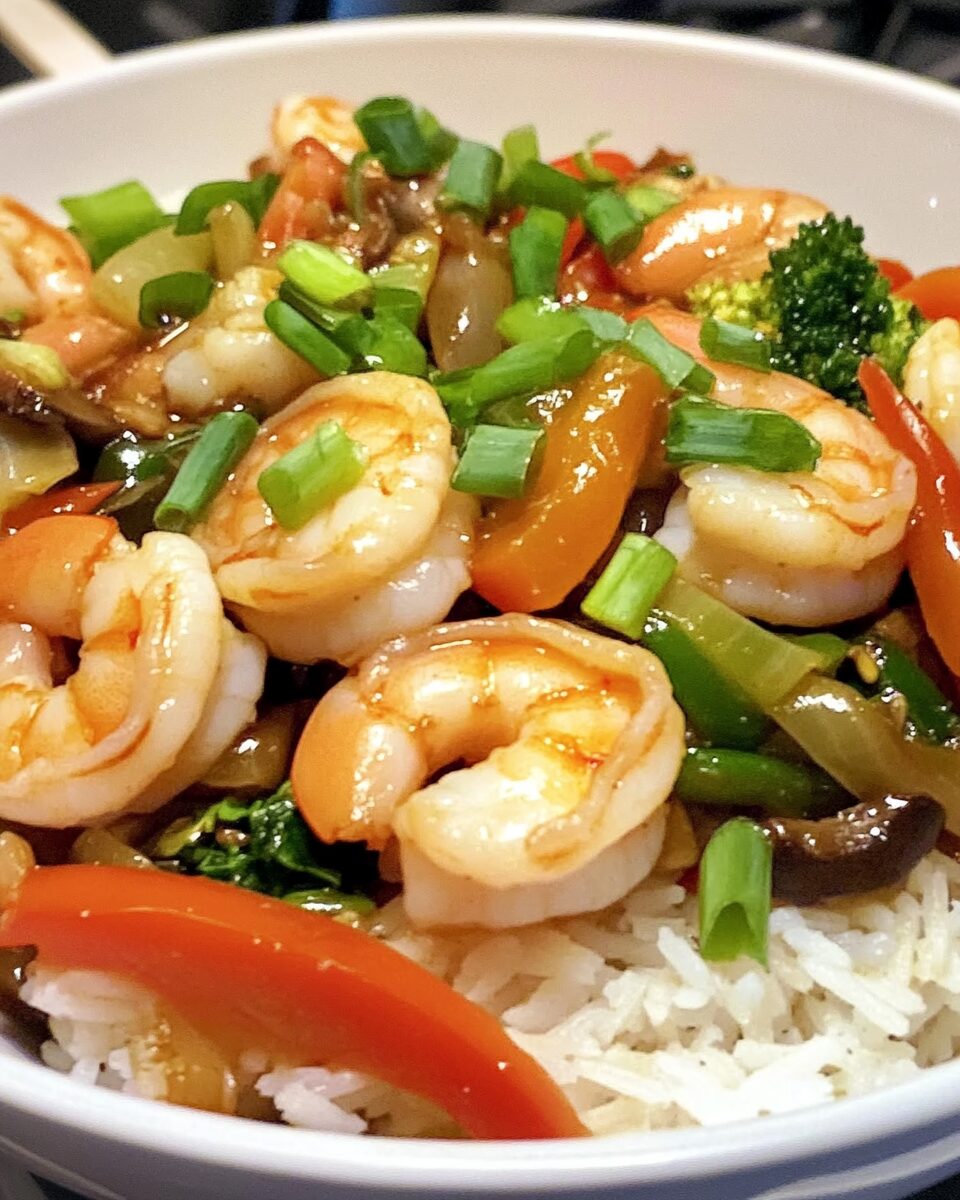Shrimp Stir-Fry is a delightful blend of tender shrimp and crisp vegetables sautéed in a savory garlic and ginger sauce. This quick and easy dish is perfect for weeknight dinners and pairs wonderfully with steamed rice.
Full Recipe:
Ingredients
- 1 cup chicken stock
- 1 tablespoon reduced-sodium soy sauce
- 1 tablespoon cornstarch
- 1 tablespoon minced garlic
- Salt and ground black pepper to taste
- 3 tablespoons sesame oil
- 1 (16-ounce) package frozen stir-fry vegetables
- 20 uncooked medium shrimp, peeled and deveined
Directions
- In a bowl, whisk together chicken stock, soy sauce, cornstarch, and minced garlic. Season with salt and pepper.
- Heat 1 tablespoon of sesame oil in a large skillet over medium-high heat. Add the shrimp and cook until they begin to turn pink, about 3 minutes.
- Add the frozen stir-fry vegetables to the skillet and cook until tender, approximately 5 minutes.
- Stir the prepared sauce into the skillet, ensuring the shrimp and vegetables are well coated. Cook until the sauce thickens, about 5 minutes.
- Serve the stir-fry hot, garnished with additional sesame oil if desired.
Nutrition Facts (per serving)
- Calories: 169
- Total Fat: 11g
- Saturated Fat: 2g
- Cholesterol: 46mg
- Sodium: 636mg
- Total Carbohydrate: 12g
- Dietary Fiber: 2g
- Sugars: 3g
- Protein: 8g
History and Origin of Shrimp Stir-Fry
Shrimp Stir-Fry is a dish that has roots in Asian cuisine, specifically in Chinese and Thai cooking. Stir-frying, a technique that involves cooking ingredients quickly over high heat in a wok or skillet, is a method that has been used for centuries in many parts of Asia. This cooking style is renowned for its ability to lock in flavors, retain nutrients, and preserve the color and texture of the ingredients, making it an ideal method for preparing shrimp and vegetables.
In particular, shrimp stir-fry has its origins in the bustling food markets of Southeast Asia, where fresh seafood, especially shrimp, is abundant. Over the years, the dish has evolved to include a variety of vegetables, sauces, and spices to suit local tastes. Whether served with rice, noodles, or on its own, shrimp stir-fry has become a staple in many households, known for being both satisfying and easy to prepare.
Why Shrimp Stir-Fry is a Great Choice for Your Meal Plan
There are several reasons why Shrimp Stir-Fry is an excellent addition to any meal plan, especially for those looking to eat healthily without sacrificing flavor. First and foremost, shrimp is a lean source of protein that is low in fat and calories. It is packed with essential vitamins and minerals, including vitamin B12, iodine, and selenium. The vegetables in the stir-fry—typically including bell peppers, broccoli, carrots, and snow peas—are rich in fiber, antioxidants, and a range of nutrients that promote overall health.
Additionally, stir-frying requires minimal oil, making it a lower-fat cooking method compared to deep frying. The high heat used in stir-frying ensures that the shrimp and vegetables cook quickly, preserving their natural textures and nutrients. This cooking method helps retain the flavor of the ingredients while maintaining their nutritional value, making it a health-conscious option for those looking to enjoy a balanced meal.
Health Benefits of Shrimp Stir-Fry
Shrimp Stir-Fry is not only delicious but also offers a variety of health benefits. The high protein content in shrimp supports muscle growth and repair, making it an excellent option for those looking to increase their protein intake. The dish is also low in carbohydrates, making it suitable for those following low-carb or ketogenic diets.
The vegetables in the stir-fry provide a wealth of nutrients, including vitamin A, vitamin C, and folate. These vitamins play a crucial role in supporting immune function, promoting healthy skin, and aiding in cell growth and repair. Additionally, the vegetables provide fiber, which aids in digestion and helps maintain healthy cholesterol levels.
One of the standout health benefits of shrimp stir-fry is its ability to provide a balanced combination of macronutrients—protein, healthy fats, and carbohydrates—along with a variety of micronutrients. This makes it a well-rounded, nutrient-dense meal that supports overall health and wellness.
Customization Options for Shrimp Stir-Fry
One of the best aspects of Shrimp Stir-Fry is its versatility. You can easily customize the dish based on your preferences, dietary needs, or what ingredients you have available. If you’re looking to make it more filling, you can serve it with a side of steamed rice or quinoa. For a low-carb option, cauliflower rice is an excellent substitute that will provide a similar texture without the added carbohydrates.
In terms of vegetables, you can mix and match based on what’s in season or what you have on hand. Broccoli, bell peppers, carrots, snap peas, and mushrooms all work wonderfully in stir-fries, but feel free to experiment with other vegetables like zucchini, bok choy, or baby corn.
The sauce is another area where you can get creative. While the basic sauce for Shrimp Stir-Fry typically includes soy sauce, sesame oil, garlic, and ginger, you can add different flavor components depending on your taste. For a bit of sweetness, you could include a touch of honey or brown sugar. If you prefer a spicier dish, add a splash of chili sauce or sriracha to give it an extra kick.
Cooking Tips for Perfect Shrimp Stir-Fry
To ensure that your shrimp stir-fry turns out perfectly every time, there are a few key tips to keep in mind. First, be sure to use fresh, high-quality shrimp. If you’re using frozen shrimp, thaw them thoroughly before cooking to ensure even cooking. It’s also important to pat the shrimp dry with paper towels to remove excess moisture, which will help them cook more quickly and prevent the dish from becoming watery.
When stir-frying, it’s essential to keep the heat high. This ensures that the shrimp and vegetables cook quickly and evenly. Be careful not to overcrowd the pan, as this can cause the ingredients to steam instead of stir-fry. If you’re cooking a large batch, it’s better to cook in batches to ensure even cooking.
Another tip is to prep all your ingredients before you begin cooking. Stir-frying happens quickly, so having everything ready to go will make the process smoother and prevent overcooking any ingredients. This includes chopping the vegetables, mincing the garlic, and preparing the sauce.
Shrimp Stir-Fry Variations
While the classic shrimp stir-fry recipe is always a hit, there are many variations you can explore to suit different tastes and occasions. For example, you can make a Shrimp and Mango Stir-Fry by adding ripe mango slices to the dish. The sweetness of the mango pairs beautifully with the savory shrimp and vegetables.
For a more exotic twist, try a Thai-inspired Shrimp Stir-Fry with coconut milk, lime, and fresh basil. The coconut milk adds a rich creaminess to the dish, while the lime gives it a fresh, zesty flavor. You can also add Thai red curry paste for an extra layer of heat.
If you’re looking for a low-carb, high-protein version, consider swapping the shrimp for another protein source, such as chicken, tofu, or beef. Each of these proteins works well in stir-fries and can be paired with the same savory sauce and vegetables.
Conclusion
In conclusion, Shrimp Stir-Fry is a delicious, healthy, and highly customizable dish that is perfect for a variety of occasions. With its combination of tender shrimp, colorful vegetables, and savory sauce, it’s sure to please even the most discerning palates.






